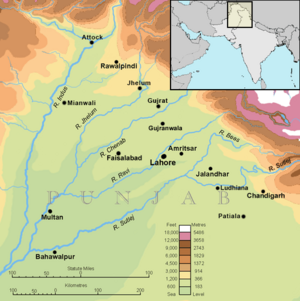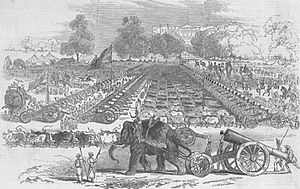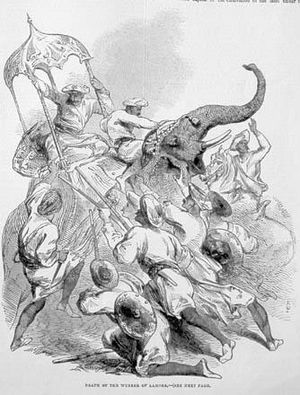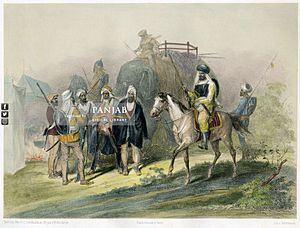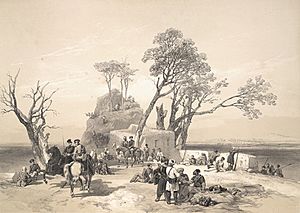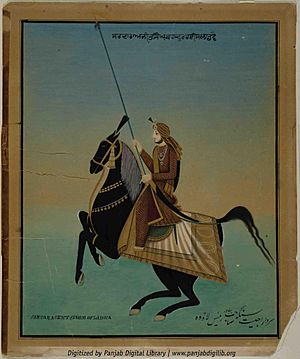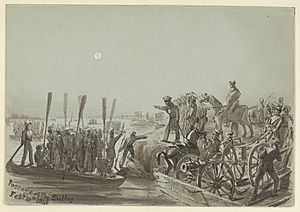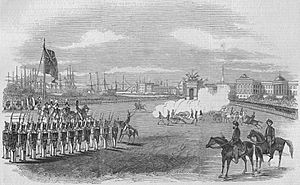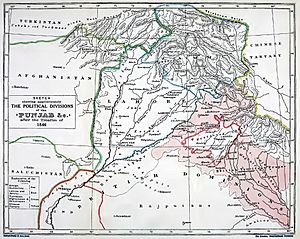First Anglo-Sikh War facts for kids
Quick facts for kids First Anglo-Sikh War |
|||||||||
|---|---|---|---|---|---|---|---|---|---|
 Sketch Map to Illustrate the First Anglo-Sikh War from 'A Short History of the Sikhs' (1915), by Charles Herbert Payne |
|||||||||
|
|||||||||
| Belligerents | |||||||||
|
|
|||||||||
| Commanders and leaders | |||||||||
|
|
|||||||||
The First Anglo-Sikh War was a conflict between the Sikh Empire and the British East India Company. It took place in 1845 and 1846 in the Punjab region of India. The war ended with the British winning, which led to the Sikh Empire losing some of its land and becoming partly controlled by the British. The region of Jammu & Kashmir was also given to a separate ruler under British control.
Contents
Why the War Started: The Background
The Sikh kingdom in Punjab grew strong under Maharajah Ranjit Singh in the early 1800s. At the same time, the British were also expanding their control in India, reaching the borders of Punjab. Ranjit Singh tried to be friends with the British, even giving up some land. But he also built up his army to protect his kingdom and fight against the Afghans. He hired soldiers from America and Europe to train his army, which included people of different faiths like Hindus and Muslims.
Changes in Punjab After Ranjit Singh
Maharajah Ranjit Singh died in 1839. After his death, his kingdom became unstable. His son, Kharak Singh, was removed from power and died mysteriously. His next son, Kanwar Nau Nihal Singh, also died soon after in strange circumstances. This led to power struggles between two main groups: the Sikh Sindhanwalias and the Hindu Dogras.
In 1841, Sher Singh became the new Maharajah, with Dhian Singh Dogra as his chief minister. The Sikh army grew very quickly during this time, from about 29,000 soldiers in 1839 to over 80,000 in 1845. The army saw itself as representing the Sikh nation. Its committees, called panchayats, gained a lot of power, making decisions for the state. British observers called this a "dangerous military democracy."
Maharajah Sher Singh struggled to pay his large army. In 1843, he was killed. After more power struggles, Jind Kaur, one of Ranjit Singh's wives, became the regent (a temporary ruler) for her young son, Duleep Singh. Her brother, Jawahar Singh, became the chief minister in 1844. He was later killed by the army in 1845. Jind Kaur remained regent, and Lal Singh became the chief minister, with Tej Singh as the army commander. Both Lal Singh and Tej Singh were originally Hindus who had converted to Sikhism.
British Actions Leading to War
After Ranjit Singh died, the British East India Company started making its military stronger. They built a military camp, called a cantonment, at Ferozepur, very close to the Sutlej River, which was the border with Punjab. In 1843, the British took over Sindh, a region south of Punjab. Many people, including some British, felt this was unfair. This action made the Sikhs in Punjab even more suspicious of British intentions.
The actions of the British leaders, like Governor General Lord Ellenborough and Sir Henry Hardinge, are still debated. The British said they were worried the Sikh army, without strong leadership, might attack their lands. However, Sikh and Indian historians argue that the British military preparations were meant for attack, not just defense. For example, they prepared special bridges and large siege guns, which would be needed for an invasion. This clear military build-up by the British near the border made the Sikhs very tense and increased the chances of war.
The Armies Involved
The Sikh Khalsa Army
The Sikh army, known as the Khalsa Army, grew from about 35,000 soldiers in the 1820s to over 100,000 by 1845. Maharajah Ranjit Singh had organized his army like the French army, and this was completed by the time he died.
The army had a special brigade called the Fauj-i-Khas (Royal Army), which was very well-trained. Other parts of the army were also modeled after this elite group. By 1845, the main army had grown to 70,000 soldiers. The Sikh cavalry (soldiers on horseback) was also strong and well-trained. There were also many irregular cavalry, good for chasing enemies or fighting in small groups.
The Sikh artillery (cannons) was very large, growing from 40 guns in 1808 to 381 by 1845, plus many smaller guns. Some of these artillery units were trained by European mercenaries (soldiers who fight for money). The British did not realize how strong the Sikh artillery was before the war began.
There was also the Jargirdar Fauj, which was an army provided by the nobles of the state. This force had about 55,000 soldiers. The army of Gulab Singh, a powerful noble, had between 12,000 and 17,000 soldiers and 94 guns. Additionally, there were about 1,000 Nihangs, who were religious warriors.
Even though the main parts of the army were Sikhs, there were also infantry units from other regions like Punjab, Pakhtun, and Kashmir. In total, the Khalsa army had about 153,000 regular and irregular soldiers. However, its main leaders, Raja Lal Singh and Tej Singh, were believed to have worked against the Sikhs during the war, even sharing information with British officers.
The British Army in India
The British army in India had three main types of soldiers:
- Regular British Army units, who were the main fighting force.
- European troops hired by the East India Company.
- Native Indian troops, called sepoys, who made up most of the army.
The sepoys often guarded places and supplies, while the European soldiers did most of the fighting. In most British fighting groups, there was usually one British unit for every three or four Indian units. The British artillery was also very strong, especially the light guns of the elite Bengal Horse Artillery.
Even though the British had many soldiers overall, they struggled to gather more than 40,000 for the war. At the end of the war, fewer than 25,000 British soldiers were actively fighting. The army was led by Sir Hugh Gough, the Commander in Chief of the Bengal Army. He was joined by Sir Henry Hardinge, the British Governor General, who put himself under Gough's command. Gough was a very aggressive leader, which sometimes almost led to disaster for his army, despite the betrayal by the Sikh generals.
The War Begins: Battles and Events
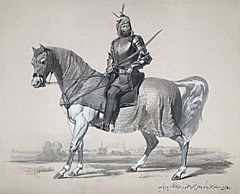
After many arguments and accusations between the Sikh government and the East India Company, talks broke down. A British East India Company army began marching towards Ferozepur, where some British soldiers were already stationed.
In response, the Sikh army started crossing the Sutlej River on December 11, 1845. The Sikhs said they were only moving into their own lands on the east side of the river. But the British saw this as a hostile act and declared war.
Ladwa Battles
Battle of Wadni Fort
After Raja Gurdit Singh died, his son Ajit Singh took over. Ajit Singh made his fort at Ladwa stronger to protect against the British. During the First Sikh War in 1845, he fought with the Sikh army. He was defeated, and the Sikh defenders of Wadni surrendered on December 30.
Battle of Phillaur Fort
This was the last battle fought by Raja Ajit Singh of Ladwa. The fort was designed by Sikh and European experts to stand against the British. Ajit Singh won this battle because of his strong fort. However, he later surrendered, realizing he could not defeat the British army alone.
Lahore Battles
Battle of Mudki
The Battle of Mudki was fought on December 18, 1845. A Sikh army led by Tej Singh moved towards the British outpost at Ferozepur but did not attack it directly. Another Sikh force, led by Lal Singh, met the British army under Gough and Hardinge at Mudki. The British won this battle, but they suffered many losses.
Battle of Ferozeshah
The Battle of Ferozeshah took place on December 21, 1845. After Mudki, Gough's army saw a large Sikh fort at Ferozeshah. Gough wanted to attack right away, but Hardinge made him wait for more soldiers to arrive. When they came on December 21, Gough attacked. The Sikh cannons caused many British casualties, and the Sikh soldiers fought bravely. However, Lal Singh kept the best Sikh cavalry away from the battle.
By nightfall, some British soldiers had entered the Sikh positions, but others were pushed back. Hardinge even thought they might lose the next day. But the next morning, the British and Indian soldiers regrouped and pushed the Sikhs out of their forts. Lal Singh did not try to reorganize his army.
Then, Tej Singh's army appeared. Gough's tired army was in danger again, but Tej Singh suddenly pulled back his troops. He claimed that British soldiers who were getting more ammunition were actually trying to surround his army.
After this, fighting stopped for a while because Gough's army was exhausted and needed more soldiers and rest.
Battle of Baddowal
The Battle of Baddowal was fought on January 21, 1846. Ranjodh Singh Majithia, a Sikh commander, crossed the Sutlej River with a large army and joined Ajit Singh of Ladwa. They marched towards Ludhiana and burned part of the British camp. Sir Harry Smith was sent to help Ludhiana.
As Smith left Baddowal, Sikh cavalry attacked his rear guard, taking most of his baggage animals and cutting down any soldiers who fell behind. Still, Smith managed to reach Ludhiana with his tired troops. He was then joined by more British and Gurkha soldiers.
Battle of Aliwal
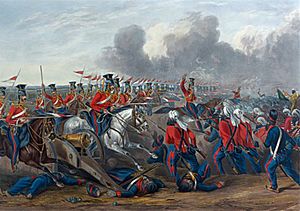
The Battle of Aliwal was fought on January 28, 1846. After resting, Smith moved back towards Baddowal. The Sikhs had moved to Aliwal on the Sutlej, waiting for more soldiers. On January 28, Smith attacked them carefully. He found a weak spot in the Sikh defenses and won a great victory. He captured almost all of the Sikh cannons and their supplies.
Battle of Sobraon
The Battle of Sobraon was fought on February 10, 1846. The Sikhs were discouraged by their losses, but they rallied when new leaders, like Sham Singh Attariwala, joined them. Maharani Jind Kaur also encouraged her officers to fight harder.
Gough wanted to attack the Sikh forts at Sobraon as soon as Smith's soldiers returned. But Hardinge made him wait for heavy cannons to arrive. Finally, on February 10, the attack began. After heavy fog lifted, 35 British heavy cannons fired for two hours, but they didn't do much damage to the Sikh forts. Gough was told his heavy guns were running out of ammunition. He is said to have replied, "Thank God! Then I'll be at them with the bayonet."
Two British groups made fake attacks on the Sikh left side, while another group made the main attack on the Sikh right. The defenses there were weaker. It is believed that Lal Singh gave this information to the British. Even so, the British were pushed back at first, and their commander, Robert Henry Dick, was killed. As the British fell back, some Sikh soldiers attacked wounded British soldiers, which made the British very angry.
The British, Gurkhas, and Indian regiments attacked again along the entire front and broke through in several places. On the weak Sikh right, engineers blew a hole in the forts, and British cavalry and cannons pushed through to fight the Sikhs in the middle. Tej Singh had left the battlefield early. Many Sikh stories say he purposely damaged the bridge, or ordered his own cannons to fire on it, to stop his soldiers from retreating. British stories say the bridge simply broke because too many soldiers were trying to cross it, and the river was swollen. Either way, the bridge broke, trapping nearly 20,000 Sikh soldiers on the east bank.
None of the trapped Sikh soldiers gave up. Many, including Sham Singh Attariwala, fought until they died. Some Sikhs charged at the British with swords; others tried to cross the river. British cannons lined the river bank and kept firing into the crowds in the water. By the time the firing stopped, the Sikhs had lost between 8,000 and 10,000 men. The British also captured 67 cannons.
Kangra Battles
Siege of Kangra Fort
This siege happened from mid-April to May 28, 1846. It was a six-week long siege of the Kangra fortress. The British took control of the valley after defeating the Sikh forces there and capturing the fort.
Mohali Battles
Battle of Sohana
Akali Hanuman Singh and 500 troops were attacked near Sohana by the British. The British defeated this force, and Hanuman Singh died at the age of 90.
What Happened After the War
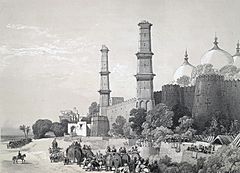
In the Treaty of Lahore on March 9, 1846, the Sikhs had to give up a valuable region between the Beas River and Sutlej River. The Sikh government also had to pay a large sum of money. Since they couldn't pay it all, they gave up Kashmir, Hazarah, and other hilly areas to the East India Company instead. Later, in a separate agreement called the Treaty of Amritsar, the Raja of Jammu, Gulab Singh, bought Kashmir from the East India Company and became the Maharajah of Jammu and Kashmir.
The land belonging to Ajit Singh of Ladwa, who fought against the British, was taken away in 1846. Ajit Singh was captured and sent to prison but managed to escape. He is believed to have died later in Kashmir.
Maharajah Duleep Singh remained the ruler of Punjab, and his mother, Maharani Jindan Kaur, was at first his regent. However, the Sikh government later asked the British to stay until the Maharajah turned 16. The British agreed, and in December 1846, a new agreement called the Treaty of Bhyroval was made. This treaty gave Maharani Jindan Kaur a pension and replaced her with a British official in Lahore, supported by a Council of Regency. This effectively gave the East India Company control over the Sikh government.
Sikh historians have often said that Lal Singh and Tej Singh, the Sikh generals, purposely started the war to weaken their own army and keep their power. They believe Lal Singh was secretly working with a British officer and giving away important information during the war. Their actions, like leaving their armies and not attacking when they had the chance, seem hard to explain otherwise.
The Sikh Empire was one of the last major kingdoms in India not under British control. Even though the Sikh army was weakened by this war, the anger over British interference in their government led to the Second Anglo-Sikh War just three years later.
See also
|


